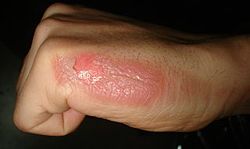Burn

Editor-In-Chief: Prab R Tumpati, MD
Obesity, Sleep & Internal medicine
Founder, WikiMD Wellnesspedia &
W8MD medical weight loss NYC and sleep center NYC
| Burn | |
|---|---|

| |
| Synonyms | Sunburn, scald |
| Pronounce | N/A |
| Specialty | N/A |
| Symptoms | Redness, peeling skin, blisters, swelling, shock |
| Complications | Infection, scarring, hypothermia, dehydration |
| Onset | Immediate |
| Duration | Days to weeks |
| Types | N/A |
| Causes | Heat, cold, electricity, chemicals, friction, radiation |
| Risks | Fire, hot liquids, sun exposure, electrical appliances |
| Diagnosis | Based on physical examination |
| Differential diagnosis | Cellulitis, erythema multiforme, toxic epidermal necrolysis |
| Prevention | Smoke detector, fire safety, sunscreen, protective clothing |
| Treatment | Cool water, pain management, antibiotics, surgery |
| Medication | Pain relievers, antibiotics |
| Prognosis | Varies by severity |
| Frequency | 11 million cases per year (worldwide) |
| Deaths | 180,000 per year (worldwide) |

A traumatic injury involving interruption of tissue cohesiveness that results from exposure to caustic chemicals, extreme heat, extreme cold or excessive radiation.
Burns are defined by how deep they are and how large an area they cover. A large burn injury is likely to include burned areas of different depths. Deep burns heal more slowly, are more difficult to treat, and are more prone to complications such as infections and scarring. Very deep burns are the most life-threatening of all and may require amputation. Types of burns include:
- First-degree burns damage the outer layer (epidermis) of the skin. These burns usually heal on their own within a week. A common example is a sunburn.
- Second-degree burns damage not only the outer layer but also the layer beneath it (dermis). These burns might need a skin graft—natural or artificial skin to cover and protect the body while it heals—and they may leave a scar.
- Third-degree burns damage or completely destroy both layers of skin including hair follicles and sweat glands and damage underlying tissues. These burns always require skin grafts.
- Fourth degree burns extend into fat, fifth degree burns into muscle, and sixth degree burns to bone.
Ad. Transform your life with W8MD's Budget GLP-1 injections from $75


W8MD offers a medical weight loss program to lose weight in Philadelphia. Our physician-supervised medical weight loss provides:
- Weight loss injections in NYC (generic and brand names):
- Zepbound / Mounjaro, Wegovy / Ozempic, Saxenda
- Most insurances accepted or discounted self-pay rates. We will obtain insurance prior authorizations if needed.
- Generic GLP1 weight loss injections from $75 for the starting dose.
- Also offer prescription weight loss medications including Phentermine, Qsymia, Diethylpropion, Contrave etc.
NYC weight loss doctor appointmentsNYC weight loss doctor appointments
Start your NYC weight loss journey today at our NYC medical weight loss and Philadelphia medical weight loss clinics.
- Call 718-946-5500 to lose weight in NYC or for medical weight loss in Philadelphia 215-676-2334.
- Tags:NYC medical weight loss, Philadelphia lose weight Zepbound NYC, Budget GLP1 weight loss injections, Wegovy Philadelphia, Wegovy NYC, Philadelphia medical weight loss, Brookly weight loss and Wegovy NYC
|
WikiMD's Wellness Encyclopedia |
| Let Food Be Thy Medicine Medicine Thy Food - Hippocrates |
Medical Disclaimer: WikiMD is not a substitute for professional medical advice. The information on WikiMD is provided as an information resource only, may be incorrect, outdated or misleading, and is not to be used or relied on for any diagnostic or treatment purposes. Please consult your health care provider before making any healthcare decisions or for guidance about a specific medical condition. WikiMD expressly disclaims responsibility, and shall have no liability, for any damages, loss, injury, or liability whatsoever suffered as a result of your reliance on the information contained in this site. By visiting this site you agree to the foregoing terms and conditions, which may from time to time be changed or supplemented by WikiMD. If you do not agree to the foregoing terms and conditions, you should not enter or use this site. See full disclaimer.
Credits:Most images are courtesy of Wikimedia commons, and templates, categories Wikipedia, licensed under CC BY SA or similar.
Translate this page: - East Asian
中文,
日本,
한국어,
South Asian
हिन्दी,
தமிழ்,
తెలుగు,
Urdu,
ಕನ್ನಡ,
Southeast Asian
Indonesian,
Vietnamese,
Thai,
မြန်မာဘာသာ,
বাংলা
European
español,
Deutsch,
français,
Greek,
português do Brasil,
polski,
română,
русский,
Nederlands,
norsk,
svenska,
suomi,
Italian
Middle Eastern & African
عربى,
Turkish,
Persian,
Hebrew,
Afrikaans,
isiZulu,
Kiswahili,
Other
Bulgarian,
Hungarian,
Czech,
Swedish,
മലയാളം,
मराठी,
ਪੰਜਾਬੀ,
ગુજરાતી,
Portuguese,
Ukrainian


